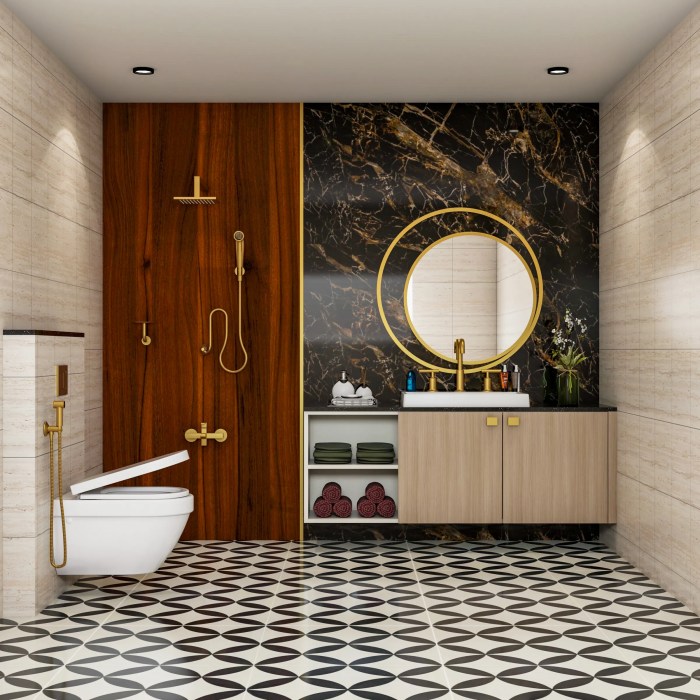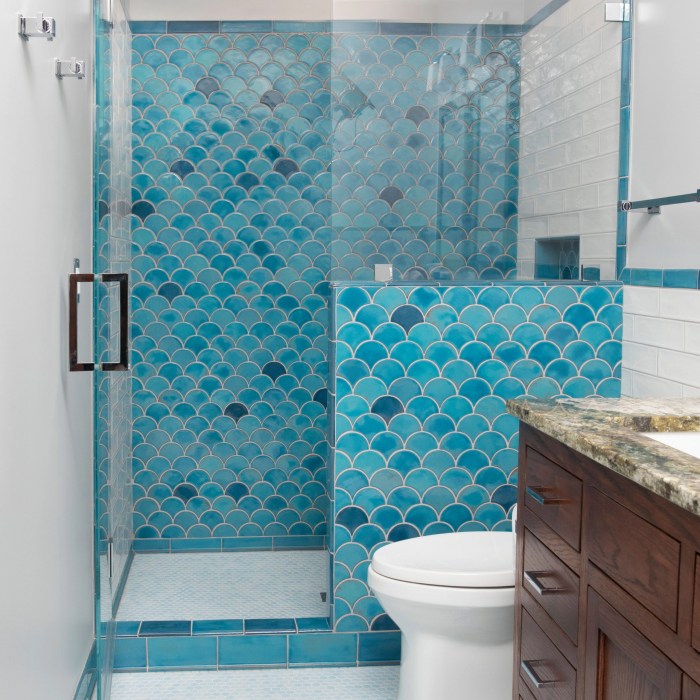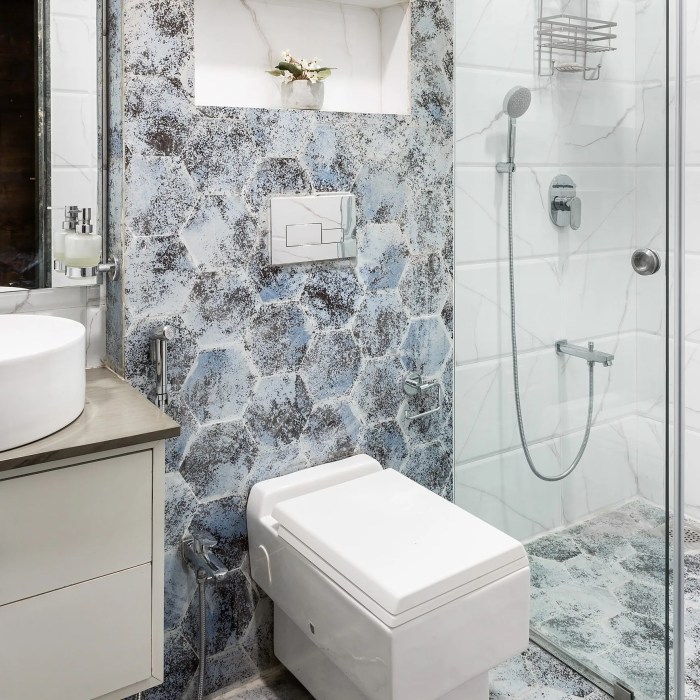Choosing the Perfect Bathroom Tiles Design: A Comprehensive Guide
Embark on a journey through the world of bathroom tiles design, where every choice shapes the ambiance and style of your space. From classic elegance to modern trends, explore the possibilities that await in this captivating realm of interior design.
Bathroom Tiles Design

Choosing the right bathroom tiles design is crucial as it can significantly impact the overall look and feel of your bathroom. The design of the tiles can create a sense of space, add personality, and enhance the aesthetic appeal of the bathroom.
Styles of Bathroom Tiles
- Ceramic Tiles: Durable and versatile, ceramic tiles come in a wide range of colors, sizes, and patterns.
- Porcelain Tiles: Known for their strength and water resistance, porcelain tiles are ideal for bathrooms.
- Marble Tiles: Elegant and luxurious, marble tiles can add a touch of sophistication to your bathroom.
- Subway Tiles: Classic and timeless, subway tiles are a popular choice for creating a clean and modern look.
Enhancing the Bathroom’s Look and Feel
Bathroom tiles play a significant role in enhancing the overall look and feel of the bathroom. They can make the space appear larger, brighter, and more inviting. Choosing the right tiles can help create a cohesive design scheme and tie together the various elements in the bathroom, such as the fixtures, countertops, and accessories.
Tile Materials

When it comes to bathroom design, choosing the right tile material is crucial for both aesthetics and functionality. Different tile materials offer unique characteristics that can impact the overall look and durability of your bathroom. Two common tile materials used in bathroom designs are ceramic and porcelain tiles.Ceramic tiles are a popular choice for bathroom floors and walls due to their versatility and affordability.
These tiles are made from clay that is kiln-fired, resulting in a durable and water-resistant material. Ceramic tiles come in a wide range of colors, patterns, and sizes, allowing for endless design possibilities in the bathroom. Additionally, ceramic tiles are easy to clean and maintain, making them a practical option for high-moisture areas like the bathroom.
Benefits of Ceramic Tiles for Bathrooms
- Ceramic tiles are water-resistant, making them ideal for wet areas like bathrooms.
- They are available in various colors, patterns, and sizes, allowing for customized designs.
- Ceramic tiles are easy to clean and maintain, requiring minimal effort to keep them looking new.
- They are cost-effective compared to other tile materials, making them a budget-friendly option for bathroom renovations.
Porcelain tiles, on the other hand, are a type of ceramic tile that is denser and more durable than standard ceramic tiles. Porcelain tiles are highly resistant to water, stains, and wear, making them an excellent choice for bathroom floors and walls.
While porcelain tiles are more expensive than ceramic tiles, they offer superior durability and longevity, making them a worthwhile investment for high-traffic areas like the bathroom.
Pros and Cons of Porcelain Tiles in Bathroom Applications
- Pros:
- Porcelain tiles are highly durable and resistant to water, stains, and wear, making them ideal for bathrooms.
- They are available in a wide range of designs, including options that mimic the look of natural stone or wood.
- Porcelain tiles are easy to clean and maintain, requiring minimal upkeep to preserve their appearance.
- Cons:
- Porcelain tiles are more expensive than ceramic tiles, which can impact the overall cost of a bathroom renovation.
- They are heavier and harder to cut than ceramic tiles, which may require professional installation.
Color and Pattern Selection
When choosing colors and patterns for bathroom tiles, it is essential to consider various factors such as the size of the bathroom, lighting, existing fixtures, and personal preferences. The right combination of colors and patterns can transform the look and feel of the space, creating a harmonious and visually appealing environment.
Selecting the Right Colors
Color plays a crucial role in setting the mood and ambiance of the bathroom. Lighter shades such as white, beige, and pastels can make a small bathroom feel more spacious and airy. On the other hand, darker colors like navy blue, charcoal, or forest green can add a sense of luxury and sophistication to a larger bathroom.
- Consider the overall color scheme of the bathroom and choose tiles that complement existing fixtures and decor.
- Use color psychology to create the desired atmosphere - for example, blue hues can promote relaxation, while yellow tones can add energy and warmth.
- Opt for timeless colors that will stand the test of time, especially if you plan to sell your home in the future.
Different Tile Patterns for Visual Interest
Tile patterns can add texture, depth, and visual interest to the bathroom. Mixing and matching different patterns can create a unique and dynamic look that reflects your personal style.
- Herringbone or chevron patterns can add a sense of movement and sophistication to the space.
- Subway tiles in a vertical or horizontal layout can elongate the walls and make the bathroom appear larger.
- Geometric patterns like hexagons or arabesque tiles can add a modern touch to a traditional bathroom design.
Impact of Color and Pattern on Perceived Size
The right combination of color and pattern can significantly impact the perceived size of the bathroom. Light colors and simple patterns can create an illusion of space, while dark colors and complex patterns can make the room feel more intimate and cozy.
- Use large-format tiles in light colors to visually expand a small bathroom.
- Consider using a monochromatic color scheme to create a seamless and cohesive look that enhances the sense of space.
- Avoid using busy patterns in a small bathroom, as they can overwhelm the space and make it feel cluttered.
Layout and Installation

When it comes to laying out and installing bathroom tiles, there are various options to consider to achieve the desired look and functionality. Proper installation is crucial for the longevity and durability of the tiles. Here is a step-by-step guide on installing bathroom tiles and the importance of proper grouting and sealing.
Different Layout Options
- Grid Layout: Tiles are laid out in a straight grid pattern, creating a clean and modern look.
- Diagonal Layout: Tiles are laid at a 45-degree angle to the walls, adding visual interest and making the space appear larger.
- Herringbone Layout: Tiles are laid in a zigzag pattern, creating a unique and stylish look.
- Basketweave Layout: Tiles are arranged in a woven pattern, adding texture and depth to the space.
Step-by-Step Guide for Installation
- Prepare the surface: Ensure the surface is clean, dry, and flat before starting the installation.
- Measure and plan: Measure the space and plan the layout of the tiles to avoid cutting small pieces at the edges.
- Apply adhesive: Spread tile adhesive on the surface using a trowel, ensuring even coverage.
- Place the tiles: Press the tiles into the adhesive in the desired layout, using spacers to maintain consistent spacing.
- Cut tiles if needed: Use a tile cutter to cut tiles to fit around edges and corners.
- Grout the tiles: Fill the gaps between the tiles with grout, using a rubber float to press it into the joints.
- Seal the tiles: Once the grout has dried, seal the tiles to protect them from moisture and stains.
Importance of Grouting and Sealing
Proper grouting is essential to prevent water from seeping under the tiles and causing damage. Grout also helps to keep the tiles in place and maintain the overall look of the installation. Sealing the tiles adds an extra layer of protection, making them easier to clean and maintain over time.
Ultimate Conclusion
As we conclude our exploration of bathroom tiles design, remember that each tile holds the power to transform your bathroom into a sanctuary of beauty and functionality. Let your creativity flow as you craft a space that reflects your unique taste and personality.
Essential FAQs
How important is it to choose the right bathroom tiles design?
Choosing the right bathroom tiles design is crucial as it sets the tone for the entire space and can significantly impact the overall aesthetic.
What are the benefits of ceramic tiles for bathrooms?
Ceramic tiles are durable, water-resistant, easy to clean, and come in a wide range of styles, making them a popular choice for bathrooms.
How do different tile patterns affect the visual interest in a bathroom?
Tile patterns can add depth and dimension to a bathroom, creating visual interest and enhancing the overall design of the space.
What are some important tips for selecting the right colors for bathroom tiles?
Consider the size of the bathroom, natural light, existing fixtures, and the desired ambiance when choosing colors for bathroom tiles.
Why is proper grouting and sealing important for bathroom tile longevity?
Grouting and sealing help prevent water damage, mold growth, and maintain the integrity of the tiles, ensuring their longevity in the bathroom environment.




